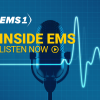Download this week’s episode on iTunes, SoundCloud or via RSS feed
In this week’s Inside EMS Podcast, co-hosts Chris Cebollero and Kelly Grayson bring on guest and EMS1 columnist Bob Sullivan to debate ALS versus BLS EMS Systems.
Cebollero asks, “What is it that a paramedic does that an EMT couldn’t do for a patient on scene?”
Sullivan said you can give EMTs the skills to manage anything that’s a life threatening emergency, but questions whether they have enough education and clinical field time to carry out the interventions.
“I think the biggest benefit to ALS is, is the patient that doesn’t look sick, but they know what questions to ask because they’re taught that at a deeper level than EMTs in America are,” Sullivan said.
The benefit of ALS is the education and training that paramedics have to better assess patients, he said.
Sullivan, who has worked in a tiered EMS system, also argues that many calls that wouldn’t normally trigger an ALS response, such as medication administration for a patient suffering from abdominal pain, would actually benefit from a paramedic response.
“That’s an issue with medical priority dispatch system,” Grayson said.
Sullivan also brings up 12-lead assessment, saying EMS should be screening patients to at least determine if it’s a code STEMI.
“My partners know how to apply 12-lead EKG,” Grayson said. “They don’t know how to interpret one. But you know something; many of my paramedic partners don’t know how to interpret one worth a darn either.”












